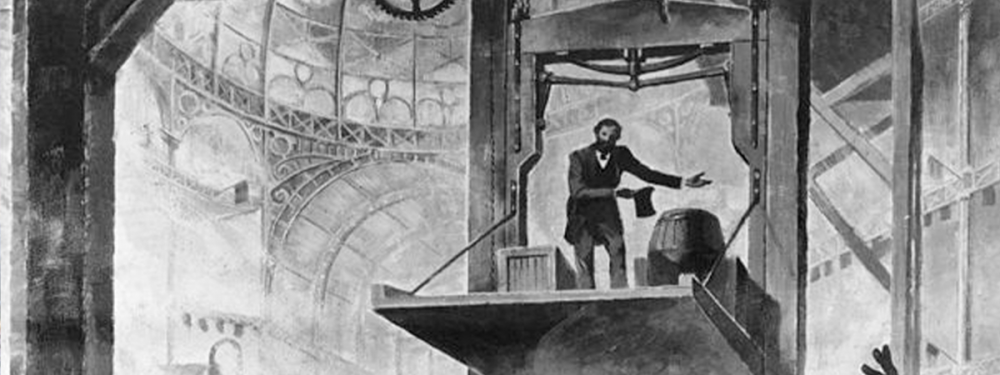Elevator journeys: How a little moving platform became a mighty symbol of the modern world
When we marvel at modern cities, we often forget the single most important innovation that made them possible: the elevator. Let’s follow the elevator on its remarkable journey, from its birth to its unique status today as the unsung shaper and enabler of our cities, our world, and our future.

Long ago, cities were very uncommon. Now, they are the norm. Cities used to be very small, as well. Now, they come in every size, all the way up to XXXL! When we think of the world today, we think of large cities. And when we think of modern cities, we think of tall buildings. But it was only possible to build or use tall buildings once important tools had been developed. One stands out – and not only because it solves a practical challenge. It also provides the ideal vehicle to bring together and symbolize some very important human needs. That’s the real story of the elevator.
A magic carpet ride
The most obvious human need met by the elevator is connection or mobility. Previous Industrial Revolution inventions had made moving things or people up and down more feasible, but elevators were not considered safe for everyday use until the 1853-54 Crystal Palace World’s Fair in New York City.
It was there that Elisha Graves Otis unveiled his safety brake in dramatic fashion. His platform elevator would rise to a height of 10 meters, and his assistant would then cut the elevator rope. When the platform didn’t crash to the ground, he would bow to the amazed crowd, and announce, “All safe!”
With safety now assured, a new era could begin for buildings, cities, and civilization. The first passenger elevator was installed in a five-story building in New York three years later: the journey of the elevator had begun. Today, elevators are the safest means of mechanized transportation in the world.

Community organizer
Elevators suddenly gave people a greater opportunity to move freely to where they wished to be. Not surprisingly, much of the time they wanted to go home or shopping, or to work, clubs, restaurants, or events. Connectivity connects places; but more importantly, it connects people.
Community building or social interaction quickly became a key element in the journey of the elevator. Elevators made it possible to create new places for people to meet and be together. Buildings grew taller, creating vastly more usable space – right out of thin air!
Vehicle of wonder
But the elevator carries more “passengers” than that. There’s curiosity as well because at every level of its rise the elevator reveals a new perspective. That leads to new questions, such as how to increase capacity or energy efficiency, or how to be more economical or personalized.
That leads to new questions, such as how to increase capacity or energy efficiency, or how to be more economical or personalized.
On an elevator, curiosity is always along for the ride. For example, in 1979, curiosity wondered if the then disruptive technology of microprocessors could be applied to elevators. They were and suddenly, the previously required operators were unnecessary. Now, anyone could operate an elevator.
By 1996, other questions led to elevator enhancers that could automatically group passengers by destination in advance, reducing waiting times and improving the elevator experience. All as a result of curiosity.
Mother of invention
But curiosity is never alone – it always brings along creativity. Asking questions leads to finding answers. Innovation is sometimes about discovering something. But more often, it is simply putting together existing building blocks of technology in a new and original way.
So, it wasn’t strange at all to put two independent cabins in one shaft. It made elevator history, though. TWIN, the first modern multi-car elevator system, was launched in 2002. The solution expanded the capacity of each elevator shaft by 40%!
The paternoster lift also used multiple cabins. Unveiled in 1868, the open cabins circulated slowly in a continuous loop. Passengers could simply step on and off as desired. Creative – although most people like to have doors on their elevators!
But by adapting this loop concept with modern mag-lev technology, the MULTI system made it possible to safely run multiple cabins up and down – and even horizontally. Unveiled in 2017, the effects of the ropeless MULTI on architectural design are only beginning. An elevator always makes space for creativity.


Urban innovations in a box
Much like a city, the elevator brings together different things in a defined space. The various elements affect and reinforce one another, and generate something completely new. In this case, connectivity, community, curiosity, and creativity intertwine with amazing and continuing effect.
One of those results is better energy efficiency. For example, net-zero energy efficiency means that an elevator generates enough power to replace the energy it uses. And even more impressive: net-positive elevators actually produce more energy than they consume!
Another example of how the elevator transports human desires to new heights is the introduction of the digital element. The first real-time, cloud-based predictive maintenance solution was released in 2015. MAX uses IoT technology to cut elevator downtime and delays.
One more for the road – The most important passenger
Is there room for one more passenger? Of course! The final and most important passenger in the journey of the elevator is called dreams. In its lifetime, the elevator has evolved from being a strange little platform or box to become a living vessel powered by the energy of the human imagination.
Why are elevators important? Because they raise up human civilization. They attract and carry the dreams of today to a higher destination – the cities of tomorrow that we have yet to build. To put it another way, elevators lift history. We’re all part of the elevator story. Get in – this journey never ends!
Image Credits
Elisha Otis Elevator, taken from wikipedia.de
